2007 NISSAN SENTRA tire type
[x] Cancel search: tire typePage 21 of 55
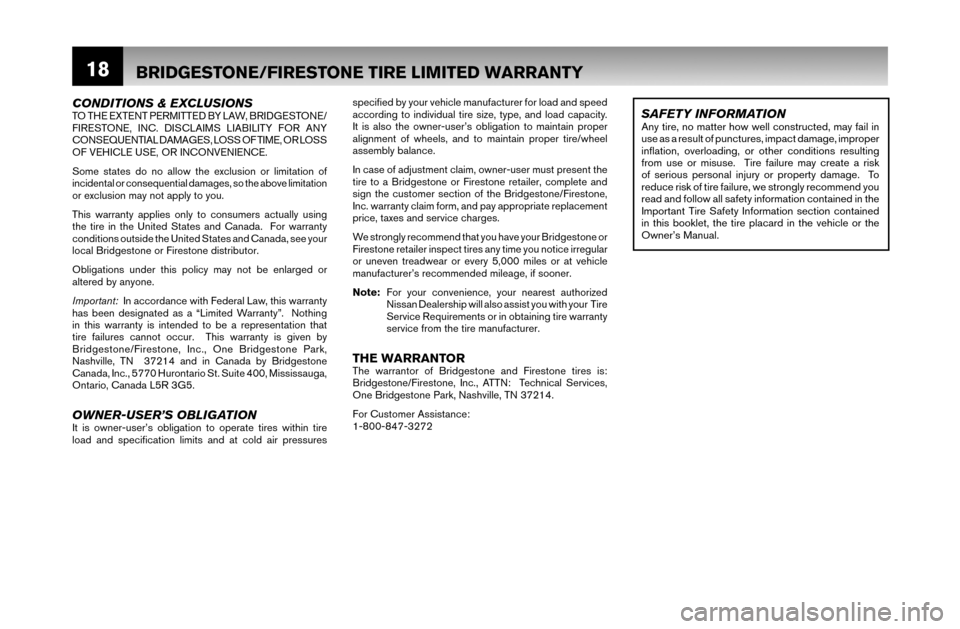
18
CONDITIONS & EXCLUSIONSTO THE EXTENT PERMITTED BY LAW, BRIDGESTONE/
FIRESTONE, INC. DISCLAIMS LIABILITY FOR ANY
CONSEQUENTIAL DAMAGES, LOSS OF TIME, OR LOSS
OF VEHICLE USE, OR INCONVENIENCE.
Some states do no allow the exclusion or limitation of
incidental or consequential damages, so the above limitation
or exclusion may not apply to you.
This warranty applies only to consumers actually using
the tire in the United States and Canada. For warranty
conditions outside the United States and Canada, see your
local Bridgestone or Firestone distributor.
Obligations under this policy may not be enlarged or
altered by anyone.
Important: In accordance with Federal Law, this warranty
has been designated as a “Limited Warranty”. Nothing
in this warranty is intended to be a representation that
tire failures cannot occur. This warranty is given by
Bridgestone/Firestone, Inc., One Bridgestone Park,
Nashville, TN 37214 and in Canada by Bridgestone
Canada, Inc., 5770 Hurontario St. Suite 400, Mississauga,
Ontario, Canada L5R 3G5.
OWNER-USER’S OBLIGATIONIt is owner-user’s obligation to operate tires within tire
load and specifi cation limits and at cold air pressures specifi ed by your vehicle manufacturer for load and speed
according to individual tire size, type, and load capacity.
It is also the owner-user’s obligation to maintain proper
alignment of wheels, and to maintain proper tire/wheel
assembly balance.
In case of adjustment claim, owner-user must present the
tire to a Bridgestone or Firestone retailer, complete and
sign the customer section of the Bridgestone/Firestone,
Inc. warranty claim form, and pay appropriate replacement
price, taxes and service charges.
We strongly recommend that you have your Bridgestone or
Firestone retailer inspect tires any time you notice irregular
or uneven treadwear or every 5,000 miles or at vehicle
manufacturer’s recommended mileage, if sooner.
Note: For your convenience, your nearest authorized
Nissan Dealership will also assist you with your Tire
Service Requirements or in obtaining tire warranty
service from the tire manufacturer.
THE WARRANTORThe warrantor of Bridgestone and Firestone tires is:
Bridgestone/Firestone, Inc., ATTN: Technical Services,
One Bridgestone Park, Nashville, TN 37214.
For Customer Assistance:
1-800-847-3272
SAFETY INFORMATIONAny tire, no matter how well constructed, may fail in
use as a result of punctures, impact damage, improper
infl ation, overloading, or other conditions resulting
from use or misuse. Tire failure may create a risk
of serious personal injury or property damage. To
reduce risk of tire failure, we strongly recommend you
read and follow all safety information contained in the
Important Tire Safety Information section contained
in this booklet, the tire placard in the vehicle or the
Owner’s Manual.
BRIDGESTONE/FIRESTONE TIRE LIMITED WARRANTY
57052 Booklet text pages.indd 1857052 Booklet text pages.indd 188/30/06 3:34:18 PM8/30/06 3:34:18 PM
Page 23 of 55

20DUNLOP PASSENGER TIRE LIMITED WARRANTY
WHAT ARE YOUR LEGAL RIGHTS?Some states and provinces do not allow the exclusion
or limitation of incidental or consequential damages,
so the above limitations or exclusions may not apply to
you. No representative or dealer has authority to make
any representation, promise, or agreement on behalf of
Goodyear Dunlop Tires North America, Ltd. (GDTNA) ,
except as stated herein.
Any tire, no matter how well constructed, may fail in
service or otherwise become unserviceable due to
conditions beyond the control of the manufacturer. Under
no circumstances is this warranty a representation that a
tire failure cannot occur.
This warranty gives you specifi c legal rights, and you may
also have other rights that vary from state to state and in
Canada province to province.
HOW DO YOU OBTAIN AN
ADJUSTMENT?
A. You must present the tire to be adjusted to an authorized
Dunlop service facility. Tires replaced on an adjustment
basis become the property of Goodyear Dunlop Tires
North America, Ltd. or Goodyear Canada Inc.
B. You must pay for taxes and any additional services you
order at the time of adjustment.
C. You must submit your claim on a GDTNA claim form
supplied by an authorized Dunlop service facility. The
form must be fi lled out completely and signed by you,
the owner of the tire presented for adjustment, or your
authorized agent.
TIRE CARE AND MAINTENANCE GUIDEThe easiest way to help ensure satisfactory mileage and
performance from your Dunlop tires is to give them a simple
but frequent inspection for proper infl ation, even treadwear,
and the presence of any damage.
DO MAINTAIN PROPER INFLATION
PRESSURE IN YOUR TIRES
Proper infl ation pressure is necessary for optimum tire
per-formance, safety and fuel economy. To maintain proper
infl ation pressure, frequently check tires (when they are
cool) with an accurate tire pressure gauge.*
For example, it is diffi cult to tell just by looking at radial
tires whether they are underinfl ated.
Furthermore, when operating a vehicle equipped with
radial tires, it is diffi cult to notice when a tire has gone
fl at or nearly fl at since the “feel” of the vehicle does not
change signifi cantly.
*Evidence of air loss or repeated underinfl ation
always requires expert inspection to determine the
source of leakage and tire removal to determine
repairability. To avoid injury, NEVER attempt to reinfl ate
a tire that has been run severely underinfl ated.
Progressive air loss may result from punctures, cuts, curbing,
impacts or partial bead unseating. Some fi tment causes for
air loss are (1) incomplete bead seating, (2) bead tearing
caused by a machine tool due to insuffi cient lubrication or
improper adjustment, (3) leaking valve core or rubber valve
components. These should be replaced when problems
are detected and whenever tires are replaced.
Always maintain infl ation pressure at the level
recommended by the vehicle manufacturer as shown
on the vehicle placard or in the owner’s manual:Underinfl ation is the leading cause of tire failure and
may result in severe cracking, component separation or
“blowout.” It reduces tire load capacity, allows excessive
sidewall fl exing and increases rolling resistance, resulting in
heat and mechanical damage. Maintaining proper infl ation
pressure is the single most important thing you can do to
ensure tire durability and maximum treadlife.
Overinfl ation increases stiffness, which may deteriorate
ride and generate unwanted vibration. Overinfl ation also
increases the chances of impact damage.
DON’T OVERLOAD YOUR VEHICLECheck your vehicle owner’s manual to determine the load
limits. Overloading your vehicle places stress on your tires
and other critical vehicle components. Overloading a vehicle
can cause poor handling, increased fuel consumption and
may cause tire failure.
Never fi t your vehicle with new tires that have less load
capacity than shown on the vehicle tire placard and
remember that optimum rim width is important for proper
tire load distribution and function.
The maximum load capacity stamped on the sidewalls of
P-Metric tires is reduced by 10 percent when used on a
light truck, utility vehicle or trailer. Never fi t P-Metric tires to
light trucks that specify LT-type replacement tires.
DON'T SPIN YOUR TIRES EXCESSIVELYAvoid excessive tire spinning when your vehicle is stuck in
snow, ice, mud or sand. The centrifugal forces generated
by a free-spinning tire/wheel assembly may cause sudden
tire explosion resulting in vehicle damage and/or serious
(Continued on page 21)
57052 Booklet text pages.indd 2057052 Booklet text pages.indd 208/30/06 3:34:19 PM8/30/06 3:34:19 PM
Page 24 of 55
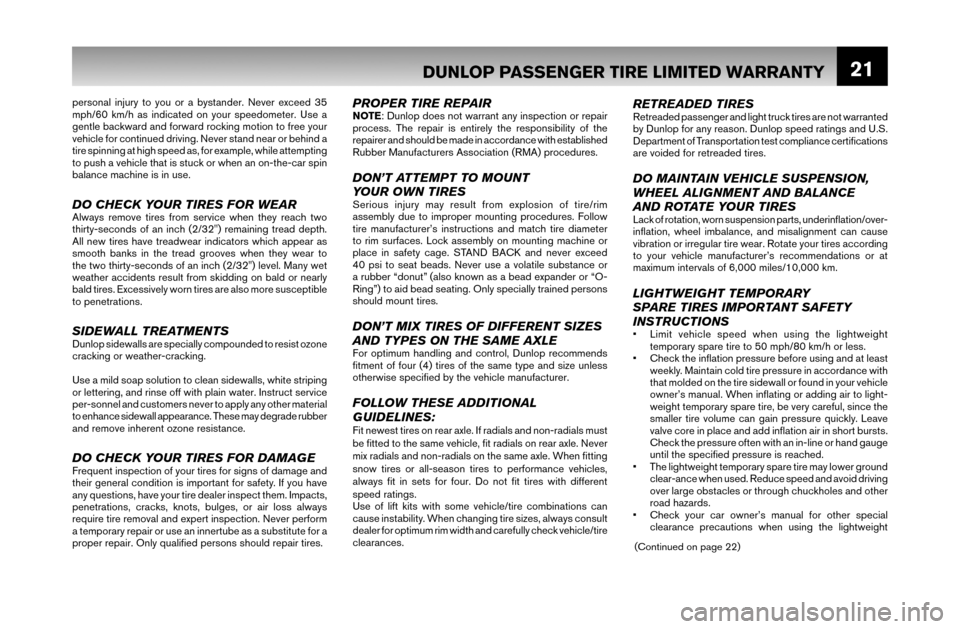
21
personal injury to you or a bystander. Never exceed 35
mph/60 km/h as indicated on your speedometer. Use a
gentle backward and forward rocking motion to free your
vehicle for continued driving. Never stand near or behind a
tire spinning at high speed as, for example, while attempting
to push a vehicle that is stuck or when an on-the-car spin
balance machine is in use.
DO CHECK YOUR TIRES FOR WEARAlways remove tires from service when they reach two
thirty-seconds of an inch (2/32") remaining tread depth.
All new tires have treadwear indicators which appear as
smooth banks in the tread grooves when they wear to
the two thirty-seconds of an inch (2/32") level. Many wet
weather accidents result from skidding on bald or nearly
bald tires. Excessively worn tires are also more susceptible
to penetrations.
SIDEWALL TREATMENTSDunlop sidewalls are specially compounded to resist ozone
cracking or weather-cracking.
Use a mild soap solution to clean sidewalls, white striping
or lettering, and rinse off with plain water. Instruct service
per-sonnel and customers never to apply any other material
to enhance sidewall appearance. These may degrade rubber
and remove inherent ozone resistance.
DO CHECK YOUR TIRES FOR DAMAGEFrequent inspection of your tires for signs of damage and
their general condition is important for safety. If you have
any questions, have your tire dealer inspect them. Impacts,
penetrations, cracks, knots, bulges, or air loss always
require tire removal and expert inspection. Never perform
a temporary repair or use an innertube as a substitute for a
proper repair. Only qualifi ed persons should repair tires.
PROPER TIRE REPAIRNOTE: Dunlop does not warrant any inspection or repair
process. The repair is entirely the responsibility of the
repairer and should be made in accordance with established
Rubber Manufacturers Association (RMA) procedures.
DON’T ATTEMPT TO MOUNT
YOUR OWN TIRES
Serious injury may result from explosion of tire/rim
assembly due to improper mounting procedures. Follow
tire manufacturer’s instructions and match tire diameter
to rim surfaces. Lock assembly on mounting machine or
place in safety cage. STAND BACK and never exceed
40 psi to seat beads. Never use a volatile substance or
a rubber “donut” (also known as a bead expander or “O-
Ring”) to aid bead seating. Only specially trained persons
should mount tires.
DON’T MIX TIRES OF DIFFERENT SIZES
AND TYPES ON THE SAME AXLE
For optimum handling and control, Dunlop recommends
fi tment of four (4) tires of the same type and size unless
otherwise specifi ed by the vehicle manufacturer.
FOLLOW THESE ADDITIONAL
GUIDELINES:
Fit newest tires on rear axle. If radials and non-radials must
be fi tted to the same vehicle, fi t radials on rear axle. Never
mix radials and non-radials on the same axle. When fi tting
snow tires or all-season tires to performance vehicles,
always fi t in sets for four. Do not fi t tires with different
speed ratings.
Use of lift kits with some vehicle/tire combinations can
cause instability. When changing tire sizes, always consult
dealer for optimum rim width and carefully check vehicle/tire
clearances.
RETREADED TIRESRetreaded passenger and light truck tires are not warranted
by Dunlop for any reason. Dunlop speed ratings and U.S.
Department of Transportation test compliance certifi cations
are voided for retreaded tires.
DO MAINTAIN VEHICLE SUSPENSION,
WHEEL ALIGNMENT AND BALANCE
AND ROTATE YOUR TIRES
Lack of rotation, worn suspension parts, underinfl ation/over-
infl ation, wheel imbalance, and misalignment can cause
vibration or irregular tire wear. Rotate your tires according
to your vehicle manufacturer’s recommendations or at
maximum intervals of 6,000 miles/10,000 km.
LIGHTWEIGHT TEMPORARY
SPARE TIRES IMPORTANT SAFETY
INSTRUCTIONS
• Limit vehicle speed when using the lightweight
temporary spare tire to 50 mph/80 km/h or less.
• Check the infl ation pressure before using and at least
weekly. Maintain cold tire pressure in accordance with
that molded on the tire sidewall or found in your vehicle
owner’s manual. When infl ating or adding air to light-
weight temporary spare tire, be very careful, since the
smaller tire volume can gain pressure quickly. Leave
valve core in place and add infl ation air in short bursts.
Check the pressure often with an in-line or hand gauge
until the specifi ed pressure is reached.
• The lightweight temporary spare tire may lower ground
clear-ance when used. Reduce speed and avoid driving
over large obstacles or through chuckholes and other
road hazards.
• Check your car owner’s manual for other special
clearance precautions when using the lightweight
DUNLOP PASSENGER TIRE LIMITED WARRANTY
(Continued on page 22)
57052 Booklet text pages.indd 2157052 Booklet text pages.indd 218/30/06 3:34:19 PM8/30/06 3:34:19 PM
Page 38 of 55
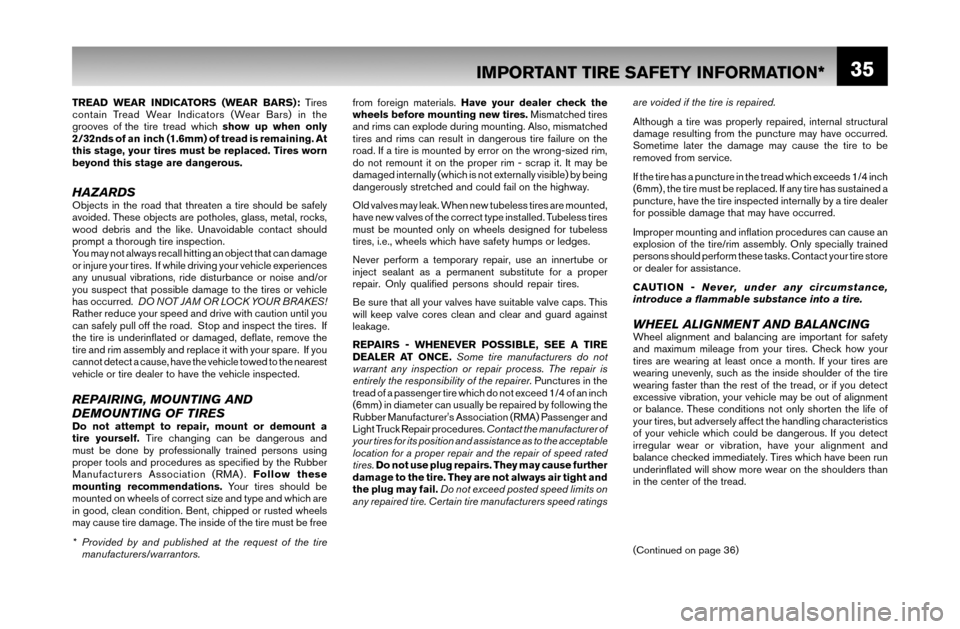
35
TREAD WEAR INDICATORS (WEAR BARS): Tires
contain Tread Wear Indicators (Wear Bars) in the
grooves of the tire tread which show up when only
2/32nds of an inch (1.6mm) of tread is remaining. At
this stage, your tires must be replaced. Tires worn
beyond this stage are dangerous.
HAZARDSObjects in the road that threaten a tire should be safely
avoided. These objects are potholes, glass, metal, rocks,
wood debris and the like. Unavoidable contact should
prompt a thorough tire inspection.
You may not always recall hitting an object that can damage
or injure your tires. If while driving your vehicle experiences
any unusual vibrations, ride disturbance or noise and/or
you suspect that possible damage to the tires or vehicle
has occurred. DO NOT JAM OR LOCK YOUR BRAKES!
Rather reduce your speed and drive with caution until you
can safely pull off the road. Stop and inspect the tires. If
the tire is underinfl ated or damaged, defl ate, remove the
tire and rim assembly and replace it with your spare. If you
cannot detect a cause, have the vehicle towed to the nearest
vehicle or tire dealer to have the vehicle inspected.
REPAIRING, MOUNTING AND
DEMOUNTING OF TIRES
Do not attempt to repair, mount or demount a
tire yourself. Tire changing can be dangerous and
must be done by professionally trained persons using
proper tools and procedures as specifi ed by the Rubber
Manufacturers Association (RMA) . Follow these
mounting recommendations. Your tires should be
mounted on wheels of correct size and type and which are
in good, clean condition. Bent, chipped or rusted wheels
may cause tire damage. The inside of the tire must be free from foreign materials. Have your dealer check the
wheels before mounting new tires. Mismatched tires
and rims can explode during mounting. Also, mismatched
tires and rims can result in dangerous tire failure on the
road. If a tire is mounted by error on the wrong-sized rim,
do not remount it on the proper rim - scrap it. It may be
damaged internally (which is not externally visible) by being
dangerously stretched and could fail on the highway.
Old valves may leak. When new tubeless tires are mounted,
have new valves of the correct type installed. Tubeless tires
must be mounted only on wheels designed for tubeless
tires, i.e., wheels which have safety humps or ledges.
Never perform a temporary repair, use an innertube or
inject sealant as a permanent substitute for a proper
repair. Only qualifi ed persons should repair tires.
Be sure that all your valves have suitable valve caps. This
will keep valve cores clean and clear and guard against
leakage.
REPAIRS - WHENEVER POSSIBLE, SEE A TIRE
DEALER AT ONCE. Some tire manufacturers do not
warrant any inspection or repair process. The repair is
entirely the responsibility of the repairer. Punctures in the
tread of a passenger tire which do not exceed 1/4 of an inch
(6mm) in diameter can usually be repaired by following the
Rubber Manufacturer's Association (RMA) Passenger and
Light Truck Repair procedures. Contact the manufacturer of
your tires for its position and assistance as to the acceptable
location for a proper repair and the repair of speed rated
tires. Do not use plug repairs. They may cause further
damage to the tire. They are not always air tight and
the plug may fail. Do not exceed posted speed limits on
any repaired tire. Certain tire manufacturers speed ratings are voided if the tire is repaired.
Although a tire was properly repaired, internal structural
damage resulting from the puncture may have occurred.
Sometime later the damage may cause the tire to be
removed from service.
If the tire has a puncture in the tread which exceeds 1/4 inch
(6mm) , the tire must be replaced. If any tire has sustained a
puncture, have the tire inspected internally by a tire dealer
for possible damage that may have occurred.
Improper mounting and infl ation procedures can cause an
explosion of the tire/rim assembly. Only specially trained
persons should perform these tasks. Contact your tire store
or dealer for assistance.
CAUTION - Never, under any circumstance,
introduce a fl ammable substance into a tire.
WHEEL ALIGNMENT AND BALANCINGWheel alignment and balancing are important for safety
and maximum mileage from your tires. Check how your
tires are wearing at least once a month. If your tires are
wearing unevenly, such as the inside shoulder of the tire
wearing faster than the rest of the tread, or if you detect
excessive vibration, your vehicle may be out of alignment
or balance. These conditions not only shorten the life of
your tires, but adversely affect the handling characteristics
of your vehicle which could be dangerous. If you detect
irregular wear or vibration, have your alignment and
balance checked immediately. Tires which have been run
underinfl ated will show more wear on the shoulders than
in the center of the tread.
* Provided by and published at the request of the tire
manufacturers/warrantors.
IMPORTANT TIRE SAFETY INFORMATION*
(Continued on page 36)
57052 Booklet text pages.indd 3557052 Booklet text pages.indd 358/30/06 3:34:27 PM8/30/06 3:34:27 PM
Page 39 of 55
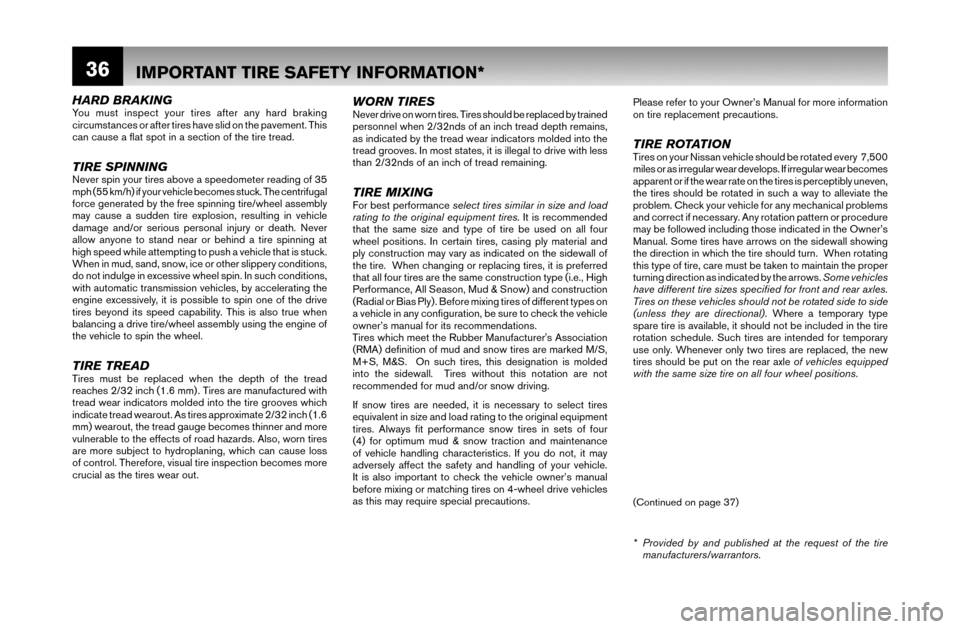
36
HARD BRAKINGYou must inspect your tires after any hard braking
circumstances or after tires have slid on the pavement. This
can cause a fl at spot in a section of the tire tread.
TIRE SPINNINGNever spin your tires above a speedometer reading of 35
mph (55 km/h) if your vehicle becomes stuck. The centrifugal
force generated by the free spinning tire/wheel assembly
may cause a sudden tire explosion, resulting in vehicle
damage and/or serious personal injury or death. Never
allow anyone to stand near or behind a tire spinning at
high speed while attempting to push a vehicle that is stuck.
When in mud, sand, snow, ice or other slippery conditions,
do not indulge in excessive wheel spin. In such conditions,
with automatic transmission vehicles, by accelerating the
engine excessively, it is possible to spin one of the drive
tires beyond its speed capability. This is also true when
balancing a drive tire/wheel assembly using the engine of
the vehicle to spin the wheel.
TIRE TREADTires must be replaced when the depth of the tread
reaches 2/32 inch (1.6 mm) . Tires are manufactured with
tread wear indicators molded into the tire grooves which
indicate tread wearout. As tires approximate 2/32 inch (1.6
mm) wearout, the tread gauge becomes thinner and more
vulnerable to the effects of road hazards. Also, worn tires
are more subject to hydroplaning, which can cause loss
of control. Therefore, visual tire inspection becomes more
crucial as the tires wear out.
WORN TIRESNever drive on worn tires. Tires should be replaced by trained
personnel when 2/32nds of an inch tread depth remains,
as indicated by the tread wear indicators molded into the
tread grooves. In most states, it is illegal to drive with less
than 2/32nds of an inch of tread remaining.
TIRE MIXINGFor best performance select tires similar in size and load
rating to the original equipment tires. It is recommended
that the same size and type of tire be used on all four
wheel positions. In certain tires, casing ply material and
ply construction may vary as indicated on the sidewall of
the tire. When changing or replacing tires, it is preferred
that all four tires are the same construction type (i.e., High
Performance, All Season, Mud & Snow) and construction
(Radial or Bias Ply) . Before mixing tires of different types on
a vehicle in any confi guration, be sure to check the vehicle
owner’s manual for its recommendations.
Tires which meet the Rubber Manufacturer's Association
(RMA) defi nition of mud and snow tires are marked M/S,
M+S, M&S. On such tires, this designation is molded
into the sidewall. Tires without this notation are not
recommended for mud and/or snow driving.
If snow tires are needed, it is necessary to select tires
equivalent in size and load rating to the original equipment
tires. Always fi t performance snow tires in sets of four
(4) for optimum mud & snow traction and maintenance
of vehicle handling characteristics. If you do not, it may
adversely affect the safety and handling of your vehicle.
It is also important to check the vehicle owner’s manual
before mixing or matching tires on 4-wheel drive vehicles
as this may require special precautions.Please refer to your Owner’s Manual for more information
on tire replacement precautions.
TIRE ROTATIONTires on your Nissan vehicle should be rotated every 7,500
miles or as irregular wear develops. If irregular wear becomes
apparent or if the wear rate on the tires is perceptibly uneven,
the tires should be rotated in such a way to alleviate the
problem. Check your vehicle for any mechanical problems
and correct if necessary. Any rotation pattern or procedure
may be followed including those indicated in the Owner’s
Manual. Some tires have arrows on the sidewall showing
the direction in which the tire should turn. When rotating
this type of tire, care must be taken to maintain the proper
turning direction as indicated by the arrows. Some vehicles
have different tire sizes specifi ed for front and rear axles.
Tires on these vehicles should not be rotated side to side
(unless they are directional) . Where a temporary type
spare tire is available, it should not be included in the tire
rotation schedule. Such tires are intended for temporary
use only. Whenever only two tires are replaced, the new
tires should be put on the rear axle of vehicles equipped
with the same size tire on all four wheel positions.
* Provided by and published at the request of the tire
manufacturers/warrantors.
IMPORTANT TIRE SAFETY INFORMATION*
(Continued on page 37)
57052 Booklet text pages.indd 3657052 Booklet text pages.indd 368/30/06 3:34:27 PM8/30/06 3:34:27 PM
Page 40 of 55
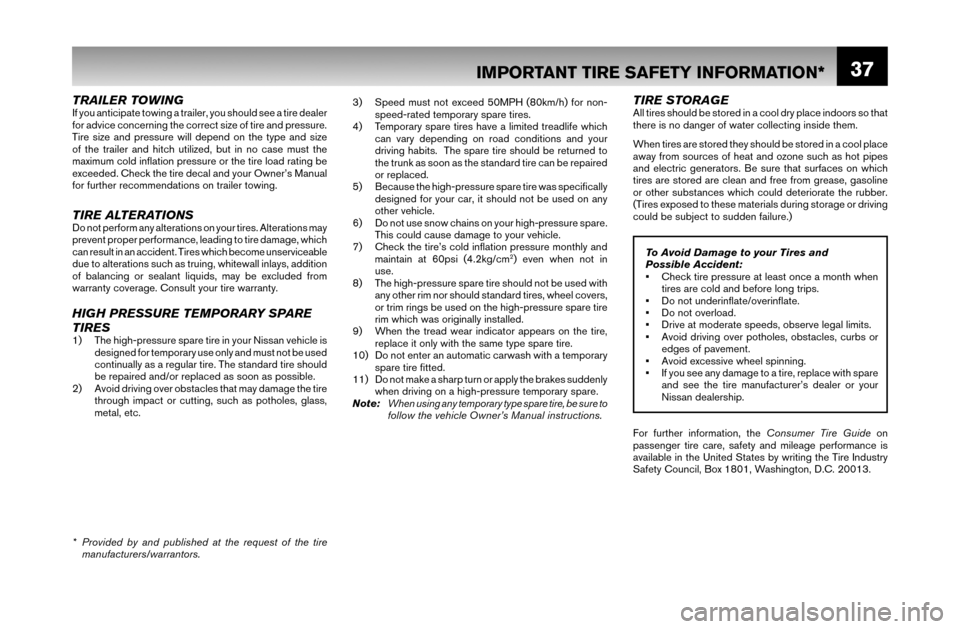
37
TRAILER TOWINGIf you anticipate towing a trailer, you should see a tire dealer
for advice concerning the correct size of tire and pressure.
Tire size and pressure will depend on the type and size
of the trailer and hitch utilized, but in no case must the
maximum cold infl ation pressure or the tire load rating be
exceeded. Check the tire decal and your Owner’s Manual
for further recommendations on trailer towing.
TIRE ALTERATIONSDo not perform any alterations on your tires. Alterations may
prevent proper performance, leading to tire damage, which
can result in an accident. Tires which become unserviceable
due to alterations such as truing, whitewall inlays, addition
of balancing or sealant liquids, may be excluded from
warranty coverage. Consult your tire warranty.
HIGH PRESSURE TEMPORARY SPARE
TIRES
1) The high-pressure spare tire in your Nissan vehicle is
designed for temporary use only and must not be used
continually as a regular tire. The standard tire should
be repaired and/or replaced as soon as possible.
2) Avoid driving over obstacles that may damage the tire
through impact or cutting, such as potholes, glass,
metal, etc.3) Speed must not exceed 50MPH (80km/h) for non-
speed-rated temporary spare tires.
4) Temporary spare tires have a limited treadlife which
can vary depending on road conditions and your
driving habits. The spare tire should be returned to
the trunk as soon as the standard tire can be repaired
or replaced.
5) Because the high-pressure spare tire was specifi cally
designed for your car, it should not be used on any
other vehicle.
6) Do not use snow chains on your high-pressure spare.
This could cause damage to your vehicle.
7) Check the tire’s cold infl ation pressure monthly and
maintain at 60psi (4.2kg/cm
2) even when not in
use.
8) The high-pressure spare tire should not be used with
any other rim nor should standard tires, wheel covers,
or trim rings be used on the high-pressure spare tire
rim which was originally installed.
9) When the tread wear indicator appears on the tire,
replace it only with the same type spare tire.
10) Do not enter an automatic carwash with a temporary
spare tire fi tted.
11) Do not make a sharp turn or apply the brakes suddenly
when driving on a high-pressure temporary spare.
Note: When using any temporary type spare tire, be sure to
follow the vehicle Owner’s Manual instructions.
TIRE STORAGEAll tires should be stored in a cool dry place indoors so that
there is no danger of water collecting inside them.
When tires are stored they should be stored in a cool place
away from sources of heat and ozone such as hot pipes
and electric generators. Be sure that surfaces on which
tires are stored are clean and free from grease, gasoline
or other substances which could deteriorate the rubber.
(Tires exposed to these materials during storage or driving
could be subject to sudden failure.)
To Avoid Damage to your Tires and
Possible Accident:
• Check tire pressure at least once a month when
tires are cold and before long trips.
• Do not underinfl ate/overinfl ate.
• Do not overload.
• Drive at moderate speeds, observe legal limits.
• Avoid driving over potholes, obstacles, curbs or
edges of pavement.
• Avoid excessive wheel spinning.
• If you see any damage to a tire, replace with spare
and see the tire manufacturer’s dealer or your
Nissan dealership.
For further information, the Consumer Tire Guide on
passenger tire care, safety and mileage performance is
available in the United States by writing the Tire Industry
Safety Council, Box 1801, Washington, D.C. 20013.
* Provided by and published at the request of the tire
manufacturers/warrantors.
IMPORTANT TIRE SAFETY INFORMATION*
57052 Booklet text pages.indd 3757052 Booklet text pages.indd 378/30/06 3:34:28 PM8/30/06 3:34:28 PM